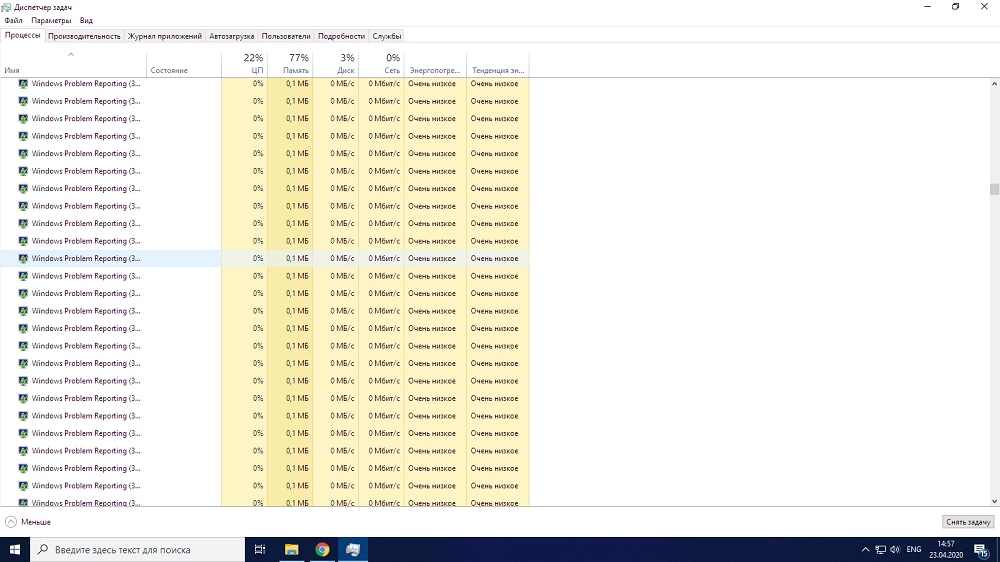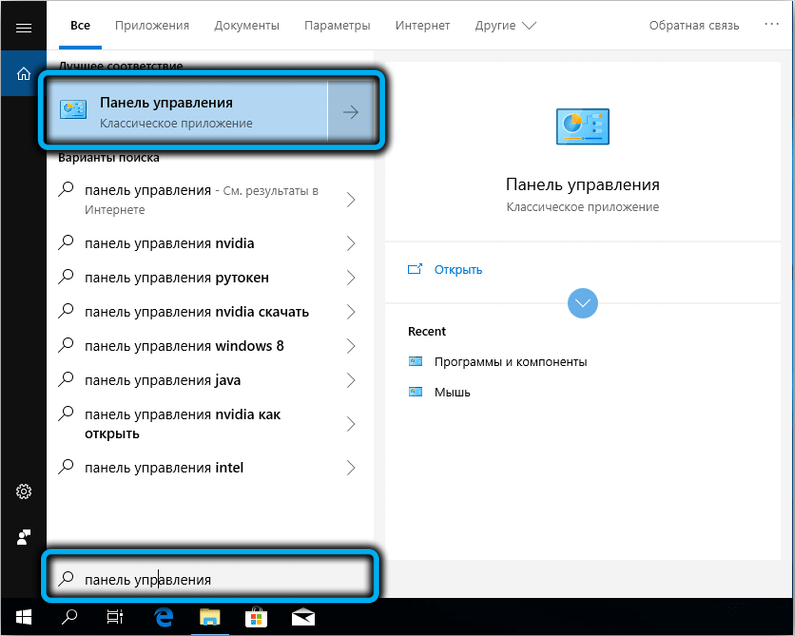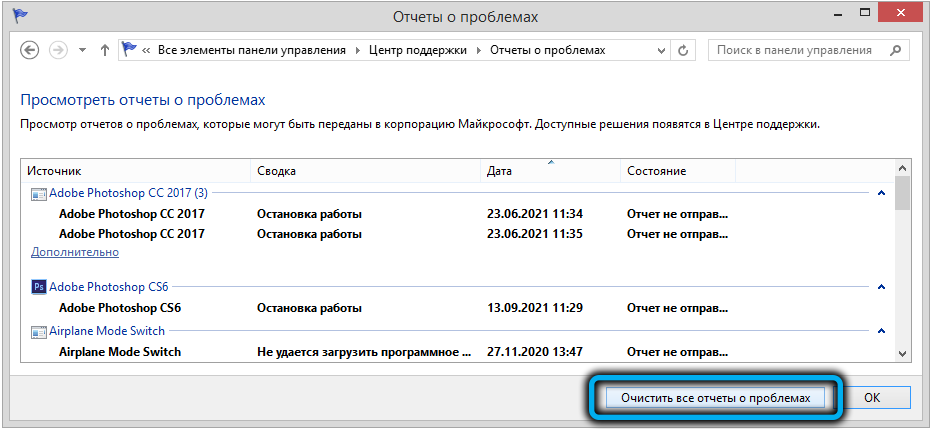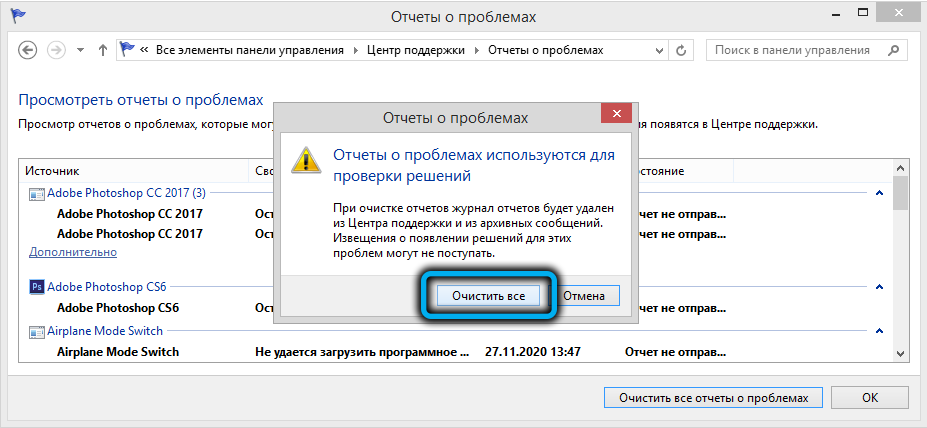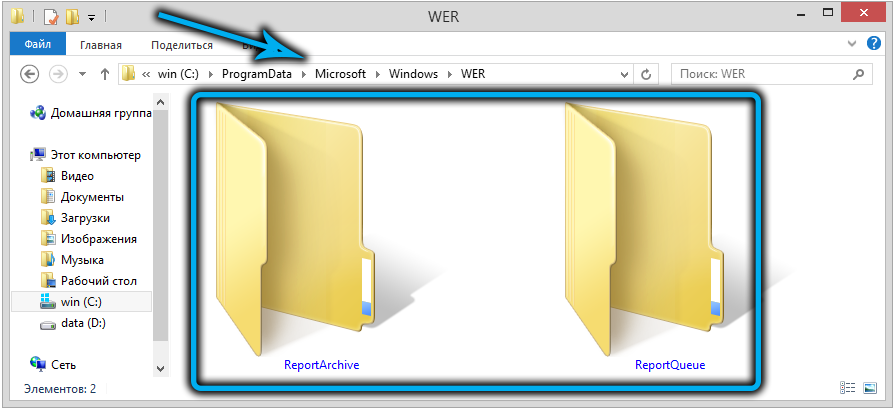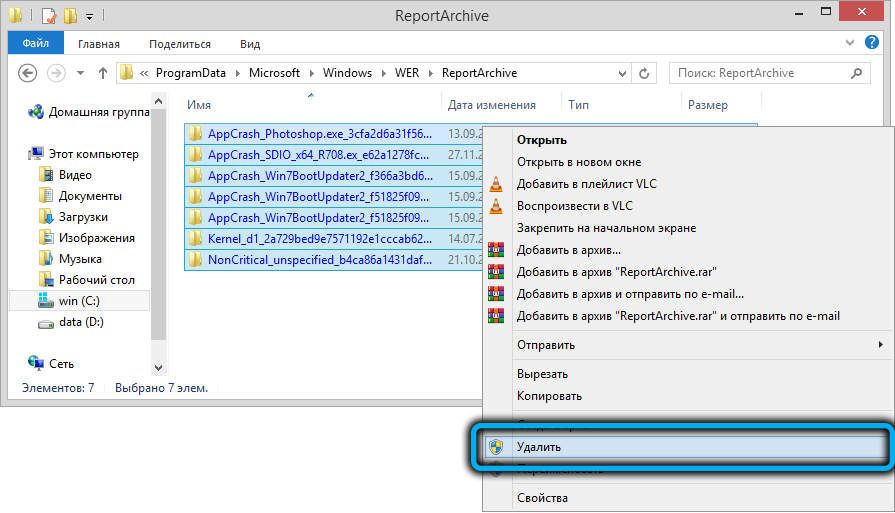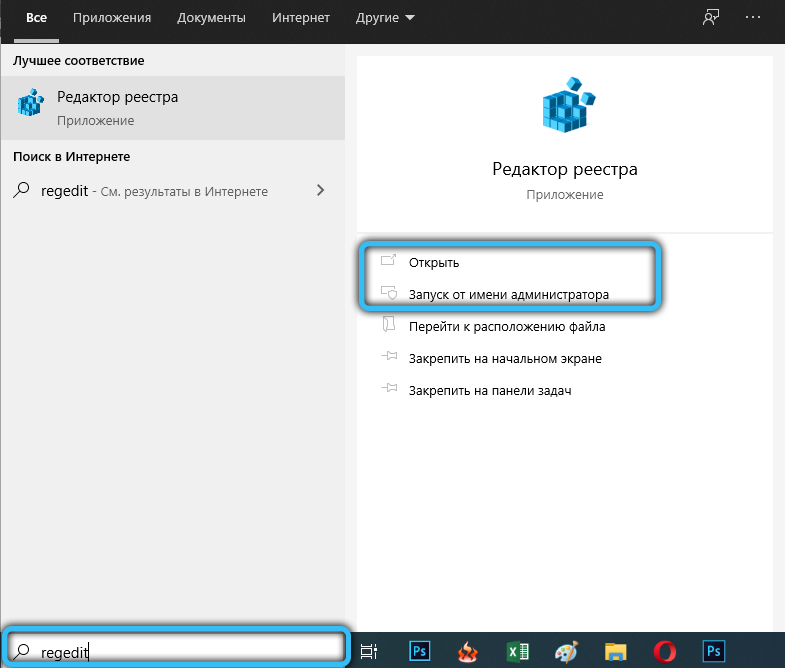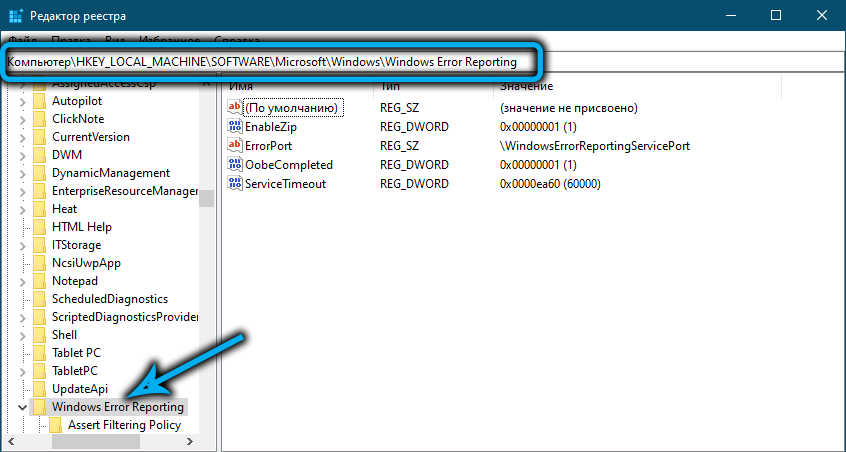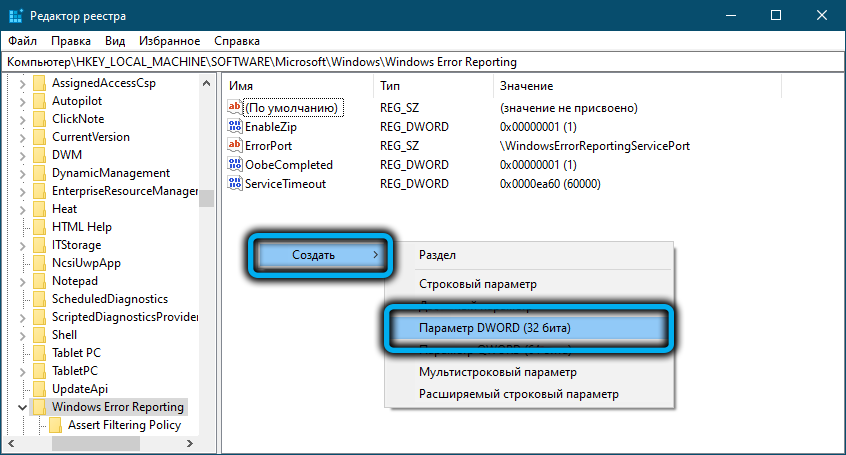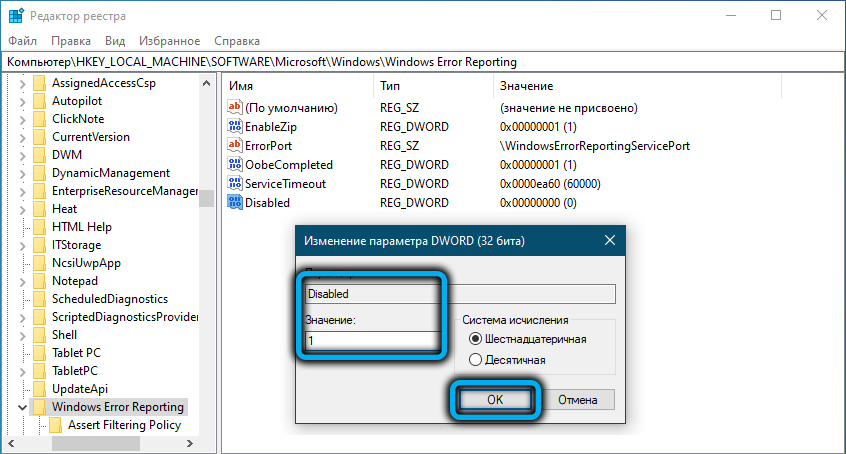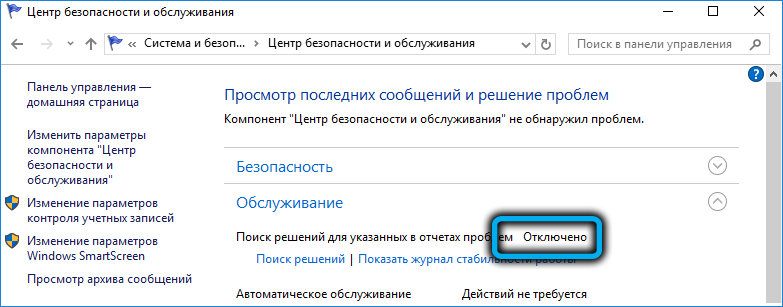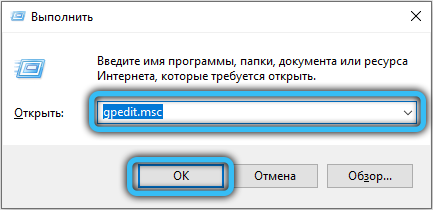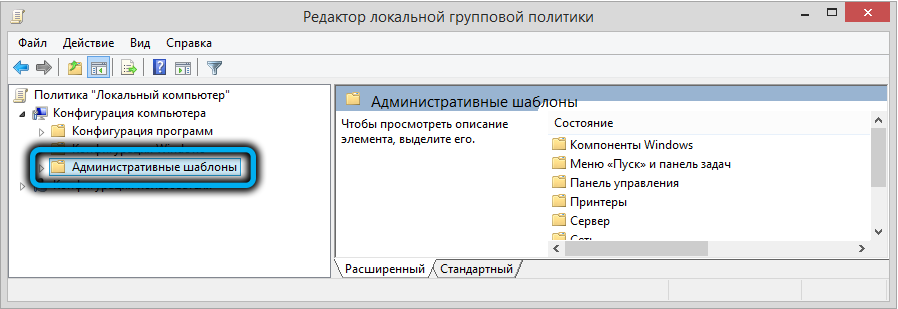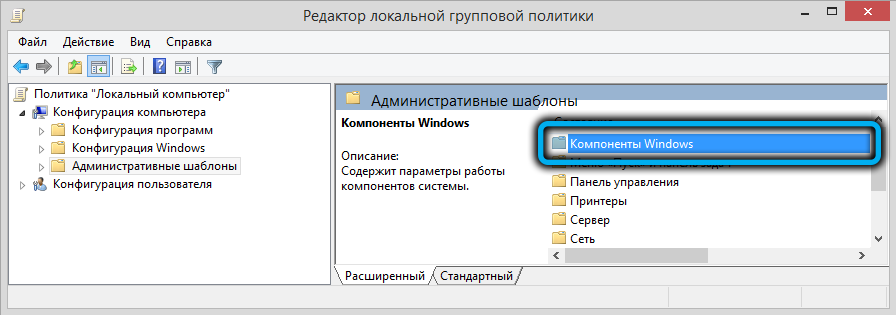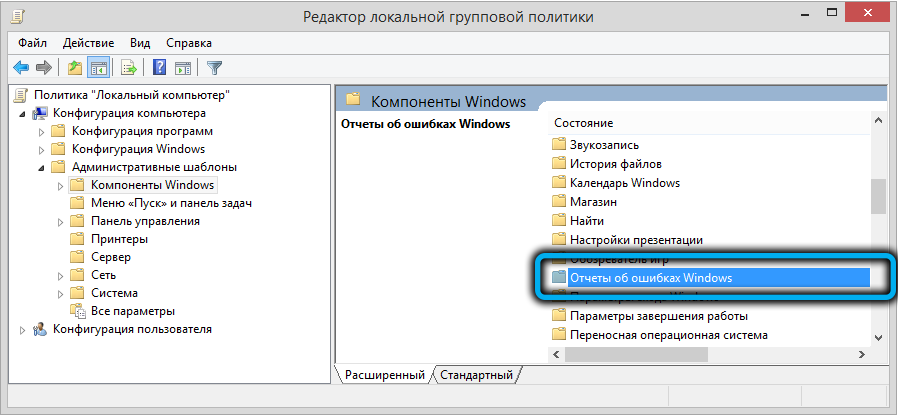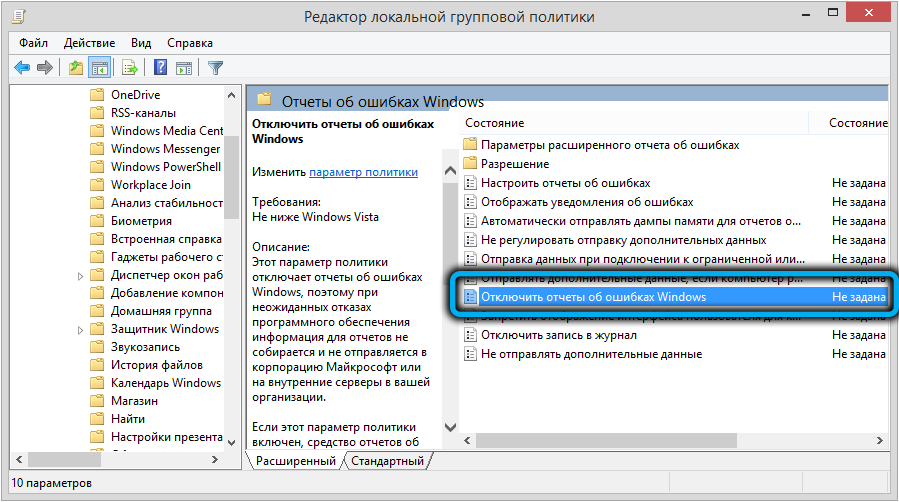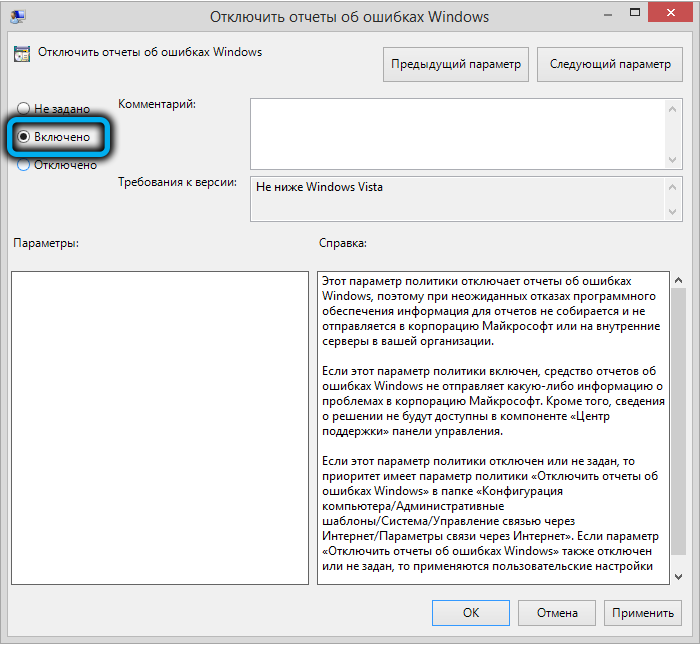С ошибками в Windows знакомо большинство пользователей. Разработчики предусмотрели реакцию операционной системы на такие события, которая заключается в отсылке отчёта о неполадке на сервере Microsoft с целью её анализа и устранения в будущих обновлениях. Насколько хорошо программисты справляются с этой задачей, мы обсуждать не берёмся, но и сама эта служба далеко не безупречна, иногда приводя к зависаниям компьютера. Сегодня мы рассмотрим, как работает Windows Error Reporting и что делать, если она начинает грузить CPU и диск.
Тот факт, что служба WER может грузить компьютер, не удивителен – это достаточно сложный механизм, который должен уметь правильно реагировать на все возникающие проблемы, независимо от того, являются ли они системным сбоем или произошли во время работы пользовательских процессов.
Принцип действия службы можно описать следующим образом: когда возникает системный сбой, срабатывает специальный механизм, отлавливающий такие случаи (на техническом языке они называются необработанными исключениями). В этом случае записываются все возможные сопутствующие факторы (например, значения стека и регистров в момент возникновения исключения), после чего запускается компонента WER, занимающаяся анализом состояния аварийно завершившегося приложения. В её функции входит также и оповещение пользователя о проблеме. Обычно это процесс WerFault.exe, который запускается с полномочиями пользователя компьютера, и по настройкам по умолчанию именно он и выводит окно, сообщающее о возникновении сбоя.
Если дефолтные настройки не менялись (а такая возможность для этой службы имеется), то созданный в результате работы анализирующего модуля отчёт с включёнными в него данными об ошибке (дамп памяти и небольшой файл в формате XML, в котором содержатся некоторые подробности типа версий DLL-библиотек, используемых аварийно завершившимся процессом) отправляется на сервера Microsoft.
После этого пользователь уведомляется о проблеме и ему предлагаются варианты действий, который можно предпринять для попытки решить эту проблему. Что, конечно же, не гарантирует нужный результат. Это же сообщение дублируется в Центре поддержки Windows. Наконец, записываются все необходимые данные о состоянии приложения и операционной системы в службу Reliability Monitor (переводится как «Монитор стабильности системы»).
ВНИМАНИЕ. Windows Error Reporting срабатывает не всегда. Обязательное условие – наличие хотя бы одного активного окна приложения, в котором произошёл сбой. Вернее, окно не обязательно должно быть активным, но должно реагировать на системные запросы, что не всегда возможно. Если интерактивности по отношению к ОС нет, сбой всё равно будет отображён в журнале, но пользователь никаких сообщений не получит. Чтобы просмотреть сведения об ошибке, ему придётся вручную его искать в Центре поддержки. Это сделано для того, чтобы не вводить в заблуждение пользователя при возникновении аварийных ситуаций, не связанных с работой приложения, то есть это могут быть фоновые системные процессы.
Как отключить Windows problem reporting
Нередко сбои в работе приложений приводят к его аварийному завершению, но, когда в дело вступает Служба оповещений об ошибках, она сама становится источником проблем. Если такие случаи возникают часто при выполнении однотипных задач (например, при вставке большого массива данных в документ), самое простое решение – отключить службу WER, раз уж она не справляется со своими прямыми обязанностями.
Рассмотрим основные способы отключения Windows problem reporting, если служба грузит диск, процессор и систему в целом.
Очистка папок службы WER
Дампы с описанием ошибок обычно небольшие, но иногда дамп памяти, который обязательно включается в файл memory.hdmp, может достигать значительных размеров, порядка многих сотен мегабайт. Если на системном диске не так много места, с десяток таких дампов могут попросту исчерпать свободное пространство, и очередному отчёту уже не будет места – вот вам и проблемы, и зависания.
Для очистки логов службы запускаем Панель управления и набираем в строке поиска текст «Просмотр всех отчетов», выбираем из списка пункт с соответствующим названием, и в новом окне жмём кнопку «Очистить все отчёты о проблемах».
Ту же операцию можно выполнить вручную, очистив две папки, WER\ReportArchive\ и WER\ReportQueue\, находящиеся в каталоге ProgramData\Microsoft\Windows\, от всего содержимого (там могут быть сотни подкаталогов).
Наконец, имеется альтернативный вариант, позволяющий удалять только старые файлы из каталогов Windows Error Reporting, причём интервал в днях, задаётся пользователем. Это команды, выполняемые через PowerShell:
Get-ChildItem -Path 'C:\ProgramData\Microsoft\Windows\WER\ReportArchive' -Recurse | Where-Object CreationTime -lt (Get-Date).AddDays(-30) | Remove-Item -force -Recurse
Get-ChildItem -Path 'C:\ProgramData\Microsoft\Windows\WER\ReportQueue' -Recurse | Where-Object CreationTime -lt (Get-Date).AddDays(-30) | Remove-Item -force –Recurse
В данном примере будут удалены все логи старше одного месяца.
Отключение WER в Windows 7/8
Но очистка логов службы – это не совсем правильное решение, ведь со временем ситуация может повториться. Проще отключить службу, ведь толку от неё мало. Делается это следующим образом:
Точно таким же образом, используя Панель управления, можно отключить службу WER в серверных версиях Windows (2019/2016/2012R2).
Отключение вывода отчётов об ошибках через системный реестр
К сожалению, в «десятке» этот простой способ не работает. Здесь имеется возможность только проверить статус службы (вкладка «Система и безопасность», переход в пункт «Центр безопасности и обслуживания», выбор подпункта «Обслуживание»). Хотя сам параметр «Отчёта о проблемах» здесь имеется, и он находится во включённом состоянии, кнопка отключения службы здесь не предусмотрена – очевидно, намеренно, чтобы иметь возможность всегда получать отчёты об ошибках.
Тем не менее, если Windows Error Reporting время от времени грузит компьютер, нужное решение имеется – для отключения службы придётся править системный реестр.
Для этого заходим в ветку HKLM\SOFTWARE\Microsoft\Windows\Windows Error Reporting.
Кликаем по пустому месту в правом окне и создаём новый параметр (выбираем тип DWORD 32-битный), присваиваем этому параметру тип Disabled, а в поле «Значение» вбиваем 1.
Следующими командами можно отключить сбор и отправку логов об ошибках для некоторых или всех пользователей:
reg add "HKCU\Software\Microsoft\Windows\Windows Error Reporting" /v "Disabled" /t REG_DWORD /d "1" /f
reg add "HKLM\Software\Microsoft\Windows\Windows Error Reporting" /v "Disabled" /t REG_DWORD /d "1" /f
Теперь, если вы зайдёте в Панель управления для проверки статуса службы, вместо On вы увидите Off, то есть у нас получилось отключить службу, призванную решать проблемы, но иногда создающую их.
При желании этот статус можно продублировать на всех компьютерах в рамках одного домена, используя GPO.
Отключение вывода отчётов об ошибках через редактор групповой политики
Действительно, если у вас есть сеть с несколькими компьютерами (а в среднем офисе их может быть десяток-другой), вместо того, чтобы выполнять все эти манипуляции энное количество раз, можно воспользоваться проверенным средством – редактором групповых политик.
Используя консоль «Выполнить», набираем команду gpmc.msc или gpedit.msc (первая – для редактора доменной GPO, вторая – для локальной). Ищем и открываем ветку Computer Configuration, затем выбираем подпункт Administrative Templates, заходим в ветку Windows Components, и наконец, кликаем по строке Windows Error Reporting.
Если в правом окне напротив параметра Disable Windows Error Reporting стоит значение Disabled, кликаем по этому параметру и в открывшемся окне изменяем его значение на Enable (Включено).
Вот и всё, теперь это правило будет действовать на все компьютерах в рамках домена. Кстати, точно такая же политика имеется в разделе User Configuration.
Как видим, для отключения службы Windows problem reporting требуется выполнить минимальное количество манипуляций, и только в Windows 10 придётся править реестр.
Many Windows 10 users have been reporting that a problematic process called “Windows Problem Reporting” has been causing significant performance drops. This happens because the process is using up an unusually high amount of CPU, slowing your computer down.
The process is also referred to as Werfault.exe, which may sound alarming to some people. Sudden processes eating up your memory are no good — in this article, you can find out what this process exactly is, and how you can get rid of the issues caused by it.
Jump to:
- What is the Windows Problem Reporting (Werfault.exe) process?
- Common Windows Problem Reporting (Werfault.exe) errors
- Guide to fix Windows Problem Reporting (Werfault.exe) errors
- Method 1: Run the System File Checker
- Method 2: Use the Windows Memory Diagnostic tool
- Method 3: Perform a Disk Cleanup
- Method 4: Scan your computer for possible viruses and malware
- Method 5: Turn Windows Problem Reporting off
What is the Windows Problem Reporting (Werfault.exe) process?
Windows Error Reporting, also referred to as Werfault.exe, is a process that handles your error reports. Whenever one of your apps crashes or runs into an issue, you can report this to Microsoft and enhance their ability to fix the issue in a future update.
Under normal circumstances, this process is not a virus or malware. However, some advanced threats can disguise themselves as the Werfault.exe process, which requires attention. Below, you can find a guide on how to scan your PC for malware, eliminating the possibility of a fake Werfault.exe existing on your device.
Common Windows Problem Reporting (Werfault.exe) errors
Even if you have a completely legitimate Windows Problem Reporting (Werfault.exe) process running on your computer, it may still be causing issues for you. We were able to collect the most common problems related to the process, making it easier to trace its source.
- Unusually high CPU usage. Perhaps the most evident issue related to this process is its high CPU usage. When your CPU is under a lot of pressure, your computer will naturally start to function slower. This can get to a level where it’s hard to perform even the most basic tasks without waiting around for everything to load.
- Corrupted or missing system files or Registry keys. If your system files or Registry keys were damaged or deleted, you may start to experience issues with Windows Problem Reporting (Werfault.exe).
- Werfault.exe Application Error. There’s always the possibility of other errors occurring concerning Werfault.exe. These issues can make using certain apps and Windows features impossible.
- Werfault.exe has encountered a problem and needs to close. We are sorry for the inconvenience. This generic Windows 10 error message can pop up and signal that you can no longer use the Windows Problem Reporting tool.
Guide to fix Windows Problem Reporting (Werfault.exe) errors
Now that we’ve taken a closer look at what the Windows Problem Reporting (Werfault.exe) process exactly is, it’s time to look for solutions. Below are several methods you can use to restore order on your computer.
Note: For some of these methods, you’re required to log in to an administrator account on your device. This is because we’ll be making changes to your system in an attempt to restore damage or change settings.
Don’t have access to an administrator account? Watch GlobalIT Resolution’s video titled “How to Create a New Administrator User Account in Windows 10.”
Let’s get started!
Method 1: Run the System File Checker
The System File Checker is a tool available in Windows 10 by default. It’s also called an “SFC scan,” and it’s your quickest way to automatically fix corrupted system files and other issues.
Here’s how to run it.
- Press the Windows + R keys on your keyboard to launch the Run utility. Type in “cmd” and press Ctrl + Shift + Enter. This is going to open the Command Prompt with administrative permissions.
- If prompted, make sure to allow the Command Prompt to make changes on your device. This means that you might need an administrator account.
- Type in the following command and press Enter: sfc /scannow.
- Wait for the System File Checker to finish scanning your computer. If it finds any errors, you’ll be able to fix them automatically through the SFC command itself, which may also fix related errors.
Method 2: Use the Windows Memory Diagnostic tool
You can attempt running the Windows Memory Diagnostic tool to solve issues related to the Windows Problem Reporting (Werfault.exe) process.
This isn’t the most reliable method, but some Windows 10 users have reported that the scan was able to identify the correct cause and offer the needed solution.
- Use the search function (available from your taskbar or by pressing the Windows + S keys on your keyboard,) to search for Windows Memory Diagnostic.
- Open the Windows Memory Diagnostic Tool from the search results.
- Click on Restart now and check for problems (recommended). This will restart your computer right away, then scan it for memory issues. Make sure you save your files and don’t have anything important open before clicking on this.
- Wait for your computer to restart. During startup, you’ll see the Windows Memory Diagnostic tool scanning your PC. If any issue is found, the tool will automatically apply a fix.
- Use your computer to determine if you still experience issues with the Windows Problem Reporting (Werfault.exe) process.
Method 3: Perform a Disk Cleanup
There is a possibility that piled-up junk on your computer might cause issues with Werfault.exe. This is because the program associated with it responds slowly due to the temporary junk files, resulting in Werfault.exe timing out.
Tip: Not everything will be caught by the Disk Cleanup tool, but it can help remove most temporary files on your computer. For more thorough cleaning, we recommend using an application such as CCleaner after Disk Cleanup.
You can clear temporary files and junk from your computer with the Disk Cleanup utility. Follow the steps below to perform a cleaning:
- Use the search function (available from your taskbar or by pressing the Windows + S keys on your keyboard,) to search for Disk Clean-up.
- Open the Disk Clean-up utility from the matching search results.
- If prompted, select the drive you want to clear and press OK. This should be the drive where Windows 10 is installed.
- Wait for the scan to complete. This might take a long time depending on the specs of your computer and the number of files you have.
- Select the type of files you want to delete under the “Files to delete” section. Here is a list of things we recommend cleaning to free up space:
- Windows Update Clean-up
- Temporary Internet Files
- Windows error reports and feedback diagnostics
- Delivery Optimization Files
- Device driver packages
- Recycle bin
- Temporary files
- Thumbnails
- Press OK and wait for the Disk Cleanup to finish. Once again, this might take a long time. Don’t turn your computer off during the process.
Method 4: Scan your computer for possible viruses and malware
We recommend checking for malware on your computer at least once every week. There is always a possibility that you clicked on a shady link or downloaded something containing malicious files. This might not be immediately obvious, and in the long run, may cause serious damage to your device and files.
If some type of malware got on your computer and tampered with Werfault.exe, it’s the reason why your errors happen.
You can use the integrated Windows Defender to combat this. It’s Windows 10’s default security solution that doesn’t cause issues and provides basic protection against most threats.
There’s also a great number of third-party antivirus software available for download, which often offers a lot more than Defender does. These applications often offer both free and paid services.
Method 5: Turn Windows Problem Reporting off
If none of the methods above seemed to fix your Werfault.exe issues, you can try disabling the Windows Error Reporting Service altogether. While this isn’t ideal, it’s most definitely going to fix your errors.
- Press and hold the Windows key on your keyboard, then hit R. This shortcut launches the Run utility.
- Write “services.msc” in the input field, then click the OK button. Doing this will bring up a new window called Services.
- Scroll down and locate the “Windows Error Reporting Service.”
- Right-click on “Windows Error Reporting Service” and choose “Properties”.
- Change the Startup type to “Disabled”.
- Press the Apply button, then the OK button.
- Restart your computer. Your device will boot up without the Windows Problem Reporting service active.
We hope this article was able to help you understand what the Windows Problem Reporting (Werfault.exe) process is and how you can get rid of its issues. If you ever notice that the process is starting to eat up your CPU again, feel free to return to this article and try our methods again!
Are you interested in learning more about Windows 10? Do you need help fixing any other Windows 10 errors and issues? You can browse our dedicated blog section and find articles about everything related to Microsoft’s groundbreaking operating system. Check our guide about werfault.exe here.
If you’re looking for a software company you can trust for its integrity and honest business practices, look no further than SoftwareKeep. We are a Microsoft Certified Partner and a BBB Accredited Business that cares about bringing our customers a reliable, satisfying experience on the software products they need. We will be with you before, during, and after all the sales.
Windows problem reporting — это служба, предоставляемая операционной системой Windows, которая отслеживает и регистрирует ошибки и проблемы, возникающие на компьютере. Эта функция предназначена для улучшения стабильности и производительности операционной системы.
Несмотря на это, некоторым пользователям может быть неудобно отправлять отчеты о проблемах, особенно если они происходят довольно часто. Кроме того, это может занимать определенное количество ресурсов системы, что может негативно сказываться на производительности компьютера.
Если вы столкнулись с ошибкой «Windows problem reporting», ищете способ ее исправить и в то же время улучшить производительность своего компьютера, вам понадобится следовать нескольким простым шагам. В этой статье мы рассмотрим несколько методов, которые помогут вам справиться с этой проблемой и оптимизировать работу операционной системы Windows.
Обратите внимание, что изменение настроек Windows problem reporting может снизить количество отправляемых отчетов, но также привести к упущению некоторых важных ошибок и проблем, которые могут возникнуть на вашем компьютере. Поэтому будьте внимательны и обдумайте все возможные последствия перед внесением изменений.
Содержание
- Как решить проблему Windows problem reporting и ускорить работу компьютера
- Что такое Windows problem reporting и для чего оно нужно?
- Как исправить ошибки Windows problem reporting безопасными методами?
Как решить проблему Windows problem reporting и ускорить работу компьютера
- Отключение службы Windows problem reporting. Чтобы отключить службу Windows problem reporting, вам необходимо выполнить следующие шаги:
- Откройте «Панель управления».
- Выберите «Система и безопасность».
- Выберите «Администрирование».
- Откройте «Службы».
- Найдите службу «Windows Error Reporting Service» и дважды щелкните на ней.
- В выпадающем списке выберите «Отключено».
- Нажмите «ОК», чтобы сохранить изменения.
- Очистка папки с отчетами об ошибках. Windows problem reporting сохраняет отчеты об ошибках на вашем компьютере. Очистка этой папки может помочь улучшить производительность компьютера:
- Откройте проводник Windows.
- Перейдите в папку «C:\ProgramData\Microsoft\Windows\WER».
- Выберите все файлы и папки внутри папки WER.
- Нажмите «Shift + Delete», чтобы удалить все выбранные файлы и папки без перемещения их в корзину.
- Подтвердите удаление.
- Изменение настроек отчетов об ошибках. Вы можете изменить настройки отчетов об ошибках, чтобы они не отправлялись разработчикам программного обеспечения:
- Откройте «Панель управления».
- Выберите «Система и безопасность».
- Выберите «Центр обновления и безопасности».
- Выберите «Изменение настроек» в разделе «Windows Update».
- Найдите ссылку «Параметры дополнительной информации об ошибках» и нажмите на нее.
- В открывшемся окне выберите «Не отсылать отчеты»
- Нажмите «OK», чтобы сохранить изменения.
Следуя указанным выше рекомендациям, вы сможете решить проблему Windows problem reporting и ускорить работу вашего компьютера. Если проблемы со скоростью работы компьютера сохраняются, рекомендуется обратиться к специалисту или обновить операционную систему до новой версии.
Что такое Windows problem reporting и для чего оно нужно?
Когда происходит сбой или ошибка в системе, Windows problem reporting собирает соответствующую информацию, включая коды ошибок, снимки памяти и предыдущие действия пользователя. Затем эти данные анонимно отправляются на серверы Microsoft для анализа.
Основная цель Windows problem reporting состоит в том, чтобы помочь разработчикам Microsoft понять и исправить возможные проблемы с операционной системой. Это позволяет улучшить производительность, стабильность и безопасность Windows.
Если вы хотите улучшить производительность своей системы и предотвратить возникновение сбоев, рекомендуется оставить включенной функцию Windows problem reporting. Она автоматически отправляет отчеты о возникших ошибках, что помогает Microsoft разрабатывать исправления и обновления операционной системы.
Однако, если вы не хотите, чтобы отчеты об ошибках отправлялись на серверы Microsoft, можно изменить настройки Windows problem reporting и отключить эту функцию. Но следует учесть, что это может снизить возможность улучшения производительности и безопасности вашей системы.
Как исправить ошибки Windows problem reporting безопасными методами?
Ошибки Windows problem reporting могут замедлять работу операционной системы и приводить к различным проблемам. Однако, перед внесением изменений, необходимо обратить внимание на то, что любые манипуляции с системными файлами могут быть опасными и вносить дополнительные проблемы. Поэтому рекомендуется предварительно создать точку восстановления или резервную копию системы.
Существует несколько способов исправления ошибок Windows problem reporting:
1. Выключение службы Windows Error Reporting:
а) Нажмите комбинацию клавиш Windows + R, чтобы открыть окно «Выполнить».
б) Введите «services.msc» (без кавычек) и нажмите Enter.
в) Найдите службу «Служба отчетов об ошибках Windows» (Windows Error Reporting Service) в списке служб.
г) Щелкните правой кнопкой мыши на службе и выберите «Свойства».
д) В разделе «Общие» выберите «Отключено» в поле «Тип запуска».
е) Нажмите кнопку «ОК» и перезагрузите компьютер.
2. Отключение отправки отчетов об ошибках:
а) Нажмите комбинацию клавиш Windows + R, чтобы открыть окно «Выполнить».
б) Введите «regedit» (без кавычек) и нажмите Enter.
в) В разделе «Редактор реестра» перейдите к следующему пути: HKEY_LOCAL_MACHINE\SOFTWARE\Microsoft\Windows\Windows Error Reporting
г) Найдите параметр Disable, и если его нет, создайте новую DWORD-значение с названием Disable.
д) Установите значение Disable в 1 (ноль используется для включения отчетов).
е) Закройте редактор реестра и перезагрузите компьютер.
3. Отключение отчетов об ошибках приложений:
а) Нажмите комбинацию клавиш Windows + R, чтобы открыть окно «Выполнить».
б) Введите «control» (без кавычек) и нажмите Enter.
в) В появившемся окне «Панель управления» выберите раздел «Система и безопасность».
г) Щелкните на ссылке «Система».
д) В левой панели выберите «Дополнительные настройки системы».
е) В окне «Свойства системы» перейдите на вкладку «Дополнительно».
ж) В разделе «Загрузка и восстановление» нажмите на кнопку «Настройка».
з) Снимите флажок с опции «Автоматическая перезагрузка» в разделе «Системные ошибки» и нажмите «ОК».
и) Закройте Панель управления и перезагрузите компьютер.
При выполнении этих действий рекомендуется следить за работой операционной системы и, при необходимости, восстановить систему из резервной копии или точки восстановления.
Windows problem reporting (отчеты о проблемах Windows) — это функция операционной системы Windows, которая собирает информацию о возникших проблемах и отправляет ее разработчикам Microsoft. Цель этой функции — улучшить качество и надежность операционной системы путем анализа информации об ошибках и выявления паттернов, которые могут помочь в поиске и исправлении проблем.
Когда в Windows происходит ошибка, система автоматически создает отчет о проблеме, который содержит информацию о состоянии системы в момент возникновения ошибки, кодах ошибок, используемом оборудовании и установленных программах. Собранные данные помогают разработчикам Microsoft определить причину проблемы и принять меры для ее устранения в следующих обновлениях операционной системы.
Тем не менее, некоторым пользователям может быть неудобно отправлять отчеты о проблемах из-за конфиденциальности данных или отсутствия доступа к интернету. В таких случаях есть возможность отключить функцию Windows problem reporting. Это позволит избежать отправки отчетов о проблемах, однако следует иметь в виду, что отключение этой функции может привести к ограничению возможностей поддержки и улучшения операционной системы.
Windows problem reporting: функция и действия при возникновении ошибок
Windows problem reporting (Сборщик данных об ошибках Windows) — это функция операционной системы Windows, предназначенная для сбора и передачи данных об ошибках и сбоях программного обеспечения Microsoft. При возникновении ошибок или критических ситуаций Windows автоматически собирает информацию о сбое, включая журналы событий, данные об использовании программ и конфигурацию компьютера.
Использование Windows problem reporting позволяет Microsoft анализировать собранные данные и выявлять причины возникновения ошибок, что позволяет разработчикам операционной системы улучшить качество и стабильность Windows. Кроме того, собранные данные об ошибках позволяют предоставлять рекомендации по устранению проблем пользователям.
При возникновении ошибки пользователю предлагается отправить отчет о сбое, после чего Windows problem reporting передает данные на серверы Microsoft для анализа. Также пользователю предоставляется возможность просмотра деталей ошибки, что может помочь в устранении проблемы самостоятельно или аппаратурных проблем.
При отправке отчета пользователь может указать, хочет ли он отправить анонимную информацию или включить дополнительные данные о своей системе. Отправка анонимной информации помогает поддерживать конфиденциальность пользователей и защищать их личные данные.
Отключение Windows problem reporting возможно, но не рекомендуется, так как это помогает сделать операционную систему более стабильной и защищенной от ошибок. Отключение функции может привести к проблемам с поддержкой и обслуживанием системы, так как разработчики операционной системы не смогут получать информацию о сбоях и труднее будет предоставить техническую поддержку.
Windows problem reporting является важным инструментом для повышения стабильности и качества операционной системы Windows. Отправка отчетов об ошибках помогает Microsoft создавать исправления и обновления, которые улучшают работу системы и обеспечивают безопасность компьютера пользователя.
Как отключить Windows problem reporting чтобы сохранить личные данные
Windows Problem Reporting (WPR) или Отчет об ошибке Windows — это сервис, который собирает информацию о проблемах и ошибках, возникающих в операционной системе Windows. Эти отчеты автоматически отправляются в корпорацию Microsoft, чтобы помочь им улучшить стабильность и надежность ОС. Однако, некоторым пользователям может быть неудобно отправлять свои личные данные и информацию об использовании системы, поэтому возникает потребность в отключении этой функции. В данной статье мы расскажем, как отключить Windows Problem Reporting.
-
Отключение через настройки операционной системы:
- Откройте меню Пуск и выберите «Параметры».
- В открывшемся окне «Параметры» выберите «Конфиденциальность».
- На панели слева выберите «Отчеты об ошибках и снимках» или «Обратная связь и диагностика».
- Настройте параметры, выбрав нужную опцию:
- «Никогда не отправлять» — полностью отключает отчеты об ошибках;
- «Отправлять только базовую информацию» — отправляет только минимально необходимую информацию без личных данных;
- «Отправлять полезные данные» — отправляет полезную информацию о проблеме, но без личных данных;
- «Отправлять полные данные» — отправляет полную информацию о проблеме, включая личные данные (рекомендуется не выбирать эту опцию).
-
Отключение через редактор реестра:
- Нажмите сочетание клавиш Win + R, чтобы открыть окно «Выполнить».
- Введите «regedit» и нажмите Enter, чтобы открыть редактор реестра.
- Перейдите по следующему пути: HKEY_LOCAL_MACHINE\SOFTWARE\Microsoft\Windows\Windows Error Reporting.
- В правой части окна найдите параметр «Disabled» и дважды кликните по нему.
- Установите значение параметра на «1» и нажмите «ОК». Если параметра «Disabled» нет, то нужно создать его.
- Перезагрузите компьютер, чтобы изменения вступили в силу.
После выполнения любого из этих методов Windows Problem Reporting будет отключен, и ваша личная информация будет сохранена. Помните, что это может привести к ухудшению работы операционной системы, поскольку Microsoft не будет получать информацию об ошибках и проблемах, возникающих у вас на устройстве. Если вы испытываете проблемы со стабильностью системы, рекомендуется включить эту функцию и помочь разработчикам улучшить качество Windows.
There are chances that a Windows 10 device experiences a problem. It’s an application or a system problem. An error message appears on the screen. However, users may become irritated if they receive frequent error warnings.
This process, also known as Werfault.exe, can use up a lot of your system’s CPU power. Don’t be concerned. There are a few simple solutions that are used to resolve this problem quickly.
Werfault.exe is another name for the process, which may be unsettling to some. Sudden procedures that chew up your memory aren’t reasonable. You’ll learn what this process is and how to get rid of the problems it causes.
What is the Windows Problem Reporting (Werfault.exe) process?

The Windows Error Reporting tool, Werfault.exe, appears anytime an application breaks. It is the indicator that Windows is trying to find a solution to the problem.
Werfault.exe may consume a significant amount of computer resources. Out-of-date device drivers or malware are two essential causes of this issue. Update your computer’s drivers and run a Malware scan. Disabling Windows Error Reporting is an easy workaround if the problem persists.
Common Windows Problem Reporting (Werfault.exe) Errors
The Windows Problem Reporting (Werfault.exe) process is genuine. It may still be causing problems for you. I compiled a list of the most prevalent issues with the procedure, making it easier to pinpoint its origin.
High CPU consumption: The high CPU utilization of this procedure is maybe the most obvious concern. When your computer’s CPU is under a lot of stress, it will naturally begin to slow down. It can make it challenging to complete even the most basic chores without waiting for things to load.
Corrupted System files and Registry keys: You may face problems with Windows Problem Reporting. Your system files or Registry keys have been corrupted or deleted (Werfault.exe).
Application Error Werfault.exe: Other issues related to Werfault.exe are always a possibility. Certain apps and Windows functions may become unusable due to these difficulties.
Werfault.exe problem: Please accept our sincere apologies for any inconvenience this may have caused. This generic Windows 10 error message may appear, indicating that the Windows Problem Reporting feature is no longer functional.
How Does the Error Reporting Service in Windows 10 Work?
Windows 10 Error Report focuses on detecting and reporting hardware and software faults from the user’s PC. Microsoft can then deliver remedies for troubleshooting based on a database of common complaints about Windows 10.
Some customers receive pop-ups or notifications while working on the computer. It urges them to submit a problem report. A Windows error report is generated when a system fails, software crashes or the operating system fails to load correctly.
Windows will typically encourage the user to file an online problem report to assist with future fixes. The name of the program, the date, the time of the fault, and the version may all be included in the problem report.
Methods To Fix Windows Error Reporting Service
- Disable Windows Error Reporting Service
- Disable Windows Error Reporting Service (Registry Editor)
- Run the System File Checker
- Perform a Disk Cleanup
- Use the Windows Memory Diagnostic tool
- Scan Your System For Viruses And Malware
- Disable Error Reporting in other Operating Systems
1. Disable Windows Error Reporting Service
On your PC, you may quickly disable the Windows error reporting service.
- To do so, hold down the Windows key and the R key at the same time.
- In the run dialog box, paste “services.msc.”

- Press ok and wait for the services window to come up.
- Look for the “Windows Error Reporting Service” in the Services pane once it has opened.

- After that, double-click on the service you want to use.
- Select “Disabled” from the “Startup type” drop-down menu.

- All you ought to do now is click on “Apply” and “OK.”
- It should bring your computer’s Werdefault.exe service to a halt.
2. Disable Windows Error Reporting Service (Registry Editor)
Another option for safely disabling Error Reporting in Windows 10 is to use the Registry key Editor. The registry is tweaked in the second technique for stopping Windows error report service.
But first, look for problems with the error reports:
- The Control Panel could be accessed in the Windows launch menu.
- Select Control Panel then System and Security. Then Security and Maintenance from the menu.

- Control panel for security and maintenance
- Keep an eye out for problems that need to be reported. Reporting issues should be turned on by default.
Steps to disable Windows Error Reporting Service.
- Press Windows+R and paste “regedit” in the box that appears.
- Then, on your keyboard, press the ‘Enter’ key.

- Click “File” after you’ve opened the Registry Editor. Then, to create a new backup on your computer, select “Export.”
- After you’ve taken a backup, navigate to
- Computer/HKEY_LOCAL_MACHINE\SOFTWARE\Microsoft\Windows\Windows Error Reporting
- Once you’ve arrived at the correct area, look for “Disabled.”
- If you don’t see the key, right-click on the empty spot, then select “New>” and “DWORD (32-bit) Value.”

- The key should be labeled “Disabled.”
- Double-click the key labeled “Disabled.” After that, change the disabled value to “1.”

- Restart your computer after closing the window. It should resolve your computer’s problem.
3. Run the System File Checker
The System File Checker is a program that comes pre-installed in Windows 10. It’s also known as an “SFC scan,” and it’s the quickest approach to automatically correct corrupted system files and other issues.
- Use the Windows + R keys on your keyboard. Press Ctrl + Shift + Enter after typing “cmd.” It will launch the Command Prompt with administrative privileges.
- Enter the command sfc /scannow into the command prompt.

- Allow the System File Checker to complete its scan of your machine.
- If it identifies any errors, it will immediately fix them using the SFC command, which may also cure associated errors.
4. Perform a Disk Cleanup
A buildup of garbage on your computer may be causing problems with Werfault.exe. Because of the temporary garbage files, its software replies slowly, causing Werfault.exe to time out.
The Disk Cleanup program can be used to remove temporary files and garbage from your computer. It will not clear any personal data.
- To find Disk Clean-up, use the search function (by pressing the Windows + S buttons on your computer).
- From the matching search results, run the Disk Clean-up program.
- Select the drive you want to clear if prompted, then hit OK. It is the drive where Windows 10 should be installed.
- Allow time for the scan to finish. Depending on the specifications of your computer and the number of files you have, this could take a long time.
- Under the “Files to remove” section, select the file types you want to delete.
- Windows Update Clean-up
- Temporary Internet Files
- Device driver packages
- Thumbnails
- Wait for the Disk Cleanup to complete before pressing OK. It could take a large time once more. During the process, do not turn off your computer.
5. Use the Windows Memory Diagnostic tool
Try running the Windows Memory Diagnostic program to resolve issues with the Windows Problem Reporting (Werfault.exe) process.
- From the search results, choose Windows Memory Diagnostic Tool.
- Check for problems by clicking on Restart Now (recommended). It will immediately restart your computer and then scan it for memory problems.
- Before clicking on this, make sure you’ve saved your files and that nothing vital is open.
- Allow for a restart of your computer. During startup, the Windows Memory Diagnostic program will scan your computer. If an error is detected, the engine will automatically correct it.
- Check your machine to see if the Windows Problem Reporting (Werfault.exe) process is still causing you problems.
6. Scan Your System For Viruses And Malware
There’s always the risk of clicking on a dodgy link or downloading something with harmful content. It may not be immediately obvious, but it might result in significant damage to your device and information in the long run.
It’s possible that malware infiltrated your machine and altered it with Werfault.exe, causing your issues. To combat this, you can utilize the built-in Windows Defender. The default security solution in Windows 10 provides rudimentary protection against the majority of attacks.
There is also a slew of third-party antivirus programs to choose from, many of which offer far more features than Defender. These apps frequently provide both free and paid services.
7. Disable Error Reporting in other Operating Systems
A. Windows 8 and Windows 7
- Activate the Control Panel.
- System and Security are the options available.
- Select the Action Center if you’re in the Control Panel’s Large Icons or Small Icons display.
- From the Action Center window’s left side, select Change Action Center settings.
- Select Problem reporting settings from the Related settings area at the bottom of the window.
- Disable all error reporting at the same time.
- On the Problem Reporting Settings window, select OK, and then on the Change Action Center settings window, select OK again. The Action Center window can now be closed.
B. Windows Vista
- Then select the Control Panel from the Start menu.
- System and Maintenance should be selected.
- Choose from a variety of Problem Reports and Solutions.
- Select Change settings on the left side of the window
- Choose one of the two possibilities:
- Choose Advanced options.
- Under the heading “For my programs, trouble reporting is,” select Off.
- Choose OK.
- On the window with the heading Choose how to look for solutions to computer problems, click OK.
- Close the window. You can also close any other open windows that are connected.
Windows XP
- To access the Control Panel, go to Start and then Control Panel.
- Performance and Maintenance should be chosen.
- Select System from the drop-down menu or from the Control Panel icon area.
- The Advanced tab should be selected.
- Near the bottom of the window, select Error Reporting.
- Select Disable error reporting from the drop-down menu.
- On the Error Reporting window, click OK.
- The Control Panel or the Performance and Maintenance window can now be closed.
Conclusion
The Windows Error Reporting feature allows Windows to retrieve error information so that bug remedies can be implemented.
